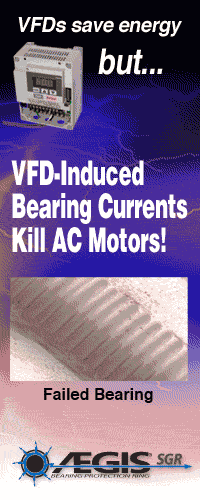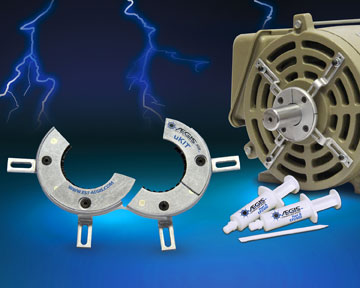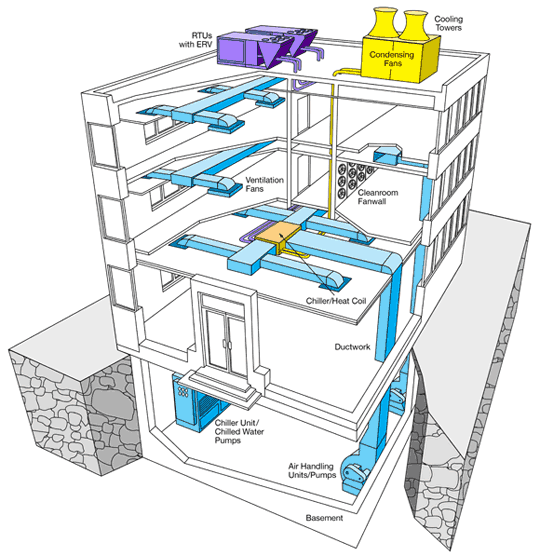Grounding of HVAC Motor Shafts
Protects Bearings, Lowers Repair Costs
By Adam Willwerth
Challenged to reduce energy consumption, facility managers are installing variable frequency drives (VFDs, also known as inverters) in heating, ventilation, and air-conditioning (HVAC) systems. By allowing motors to run at less than full speed, these drives can yield energy savings of 20-30%, but they also induce currents that can damage bearings and shorten motor life. The resulting repair costs can wipe out any savings from their use. To make HVAC systems sustainable as well as energy-efficient, a reliable method of bearing protection is required.
VFD-Induced Currents Destroy Bearings, Kill Motors
Although the energy-saving potential of VFDs was never in dispute, for years the true cause of VFD-induced bearing failure was often misdiagnosed. Eventually, repair shops and testing consultants proved that the high peak voltages, fast voltage rise times, non-sinusoidal shaft currents, and parasitic capacitance associated with typical pulse-width-modulated VFDs lead to the cumulative erosion of bearings.
Without mitigation, voltages repeatedly build up on the motor shaft to a certain threshold, then discharge in short bursts along the path of least resistance, which all too often runs through the motor’s bearings. The discharge rate tends to increase with carrier frequency.
Continued discharges result in the pitting of the balls and race walls through electrical discharge machining (EDM). Concentrated pitting at regular intervals along the race wall can cause washboard-like ridges called fluting, a source of vibration and noise that can reverberate through ductwork.
Protecting Motor Bearings From Electrical Damage
Some bearing protection products, such as insulated or ceramic bearings, can shift the damage elsewhere. In fact, standards issued by the National Electrical Manufacturers Association (NEMA) highlight the need for extra bearing protection for VFD-driven motors but point out that bearing insulation alone will not prevent damage to other connected equipment. When the path to the bearings is blocked, the damaging current seeks another path to ground. That other path often runs through a pump, gearbox, tachometer, or other device, which can consequently wind up with bearing damage of its own.
Many so-called “inverter-duty” motors offer beefed-up winding insulation, but do not guard against bearing damage. If they are to be truly ready for use with VFDs, these motors also need bearing protection.
Some other products designed to protect bearings from electrical damage, such as conventional spring-loaded grounding brushes, require extensive maintenance themselves.
One of the most promising protective devices diverts damaging currents safely to ground, bypassing the motor’s bearings. Installed around the shaft of a VFD-controlled motor, the maintenance-free AEGIS® SGR Bearing Protection Ring extends motor life and qualifies as sustainable technology under the Federal Energy Management Program. While a small number of forward-thinking OEMs are now offering motors with AEGIS® rings factory installed, retrofits are still the most common way to protect bearings from VFD-induced shaft currents.
Preventive Maintenance
As preventive maintenance for motors already in service, the AEGIS® ring can be quickly and easily retrofitted onto virtually any motor regardless of shaft size, horsepower, or end-bell protrusion using conducive epoxy and/or a new Universal Mounting Kit [Figure 1]. Conductive microfibers, which line the ring’s entire inner circumference in two rows, boost the electron-transfer rate.
 Figure 1: The new Split uKIT universal mounting kit includes an AEGISŪ ring that comes in halves (with mounting hardware) for easy installation without detaching motor from coupled equipment. | |
The AEGIS® ring has been proven in hundreds of thousands of installations. HVAC applications include rooftop systems, indoor and outdoor air handling units, ventilation fans, fan walls, air- or water-cooled chillers, chilled water and other pumps, condensing fans, and compressors [Figure 2].

Figure 2: To save energy and help make buildings “green,” AC motors in many types of HVAC equipment today are controlled by variable frequency drives, leaving them vulnerable to bearing damage. This diagram shows some of these applications where shaft grounding makes motors and systems sustainable as well as energy-efficient. |
Shaft Grounding Proven Effective on Rooftop Unit
Electro Static Technology (EST), the manufacturer of the AEGIS® ring, recently demonstrated the ring’s effectiveness on a typical rooftop air conditioning unit at a Michigan department store. EST technicians took voltage readings from one of the unit’s VFD-controlled fan motors both before and after installing the ring on the motor’s shaft.
In a continuous 60-μsec trace with the motor running at 3,600 rpm (80 Hz output), discharges from the shaft measured 44.8 volts peak-to-peak, high enough to cause pitting of the motor’s bearings (oscilloscope settings: 10v/div, 5 msec/div). After the grounding ring was installed, a follow-up test at 3,600 rpm showed that discharges had dropped to only 3.76 volts peak-to-peak (oscilloscope settings: 2v/div, 500 μsec/div). In short, the AEGIS® SGR Bearing Protection Ring reduced shaft currents by 92% — to levels well below those that damage bearings.
Sustainable Energy Savings
VFDs hold the promise of sizable energy savings, but all VFD-driven motors are vulnerable to electrical bearing damage. Without effective, long-term bearing protection for VFD-controlled motors, any savings could be wiped out by high maintenance costs. A savvy specifier will choose new motors that are truly equipped for use with today’s fast-switching VFDs. But for motors already in service, retrofitting with an economical device such as a shaft grounding ring is the best approach.
By diverting bearing currents safely to ground, AEGIS® SGR Bearing Protection Rings promote the reliable, long-term operation of VFD-driven HVAC systems, locking in energy savings to make these systems sustainable and truly “green.”
Adam Willwerth is Marketing Manager for Electro Static Technology, 31 Winterbrook Road, Mechanic Falls, ME 04256-5724, TEL: (207) 998-5140, FAX: (207) 998-5143,
www.est-aegis.com.
Information courtesy of Electro Static Technology
|

